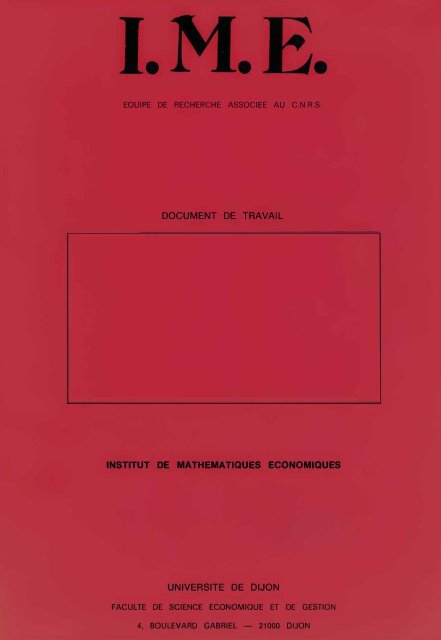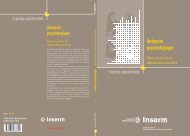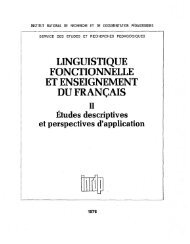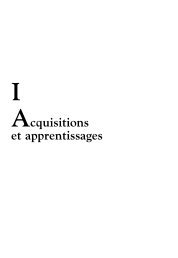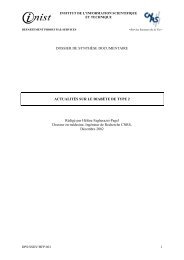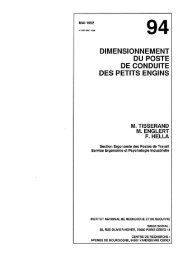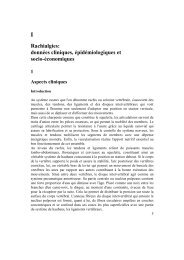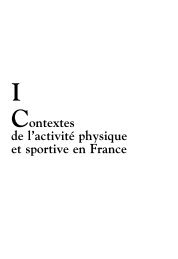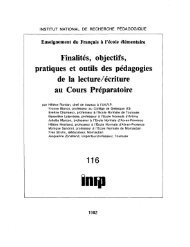document de travail institut de mathematiques economiques ... - Lara
document de travail institut de mathematiques economiques ... - Lara
document de travail institut de mathematiques economiques ... - Lara
Create successful ePaper yourself
Turn your PDF publications into a flip-book with our unique Google optimized e-Paper software.
EQUIPE DE RECHERCHE ASSOCIEE AU C.N.R.S.<br />
DOCUMENT DE TRAVAIL<br />
INSTITUT DE MATHEMATIQUES ECONOMIQUES<br />
UNIVERSITE DE DIJON<br />
FACULTE DE SCIENCE ECON OMIQUE ET DE GESTION<br />
4, BOULEVARD GABRIEL - 21000 DIJON
ABSTRACT MODELS FOR SYSTEMS IDENTIFICATION<br />
Dar, A. RALESCU<br />
Juin 1977<br />
Le but <strong>de</strong> cette collection est <strong>de</strong> diffuser rapi<strong>de</strong>ment une première<br />
version <strong>de</strong> travaux afin <strong>de</strong> provoquer <strong>de</strong>s discussions scientifiques. Les<br />
lecteurs désirant entrer en rapport avec un auteur sont priés d'écrire<br />
â l'adresse suivante :<br />
INSTITUT DE MATHEMATIQUES ECONOMIQUES<br />
4, Bd Gabriel - 21000 DIJON - France
TRAVAUX DEJA PUBLIES<br />
N°1 Michel PREVOT : Théorème du point fixe. Une étu<strong>de</strong> topologique générale<br />
(juin 1974)<br />
N°2 Daniel LEBLANC : L'introduction <strong>de</strong>s consommations intermédiaires dans<br />
le modèle <strong>de</strong> LEFEBER (juin 1974)<br />
N°3 Colette BOUNON : Spatial Equilibrium of the Sector in Quasi-Perfect<br />
Competition (September 1974)<br />
N°4 Clau<strong>de</strong> PONSARD : L'imprécision et son traitement en analyse économique<br />
(septembre 1974)<br />
N°5 Clau<strong>de</strong> PONSARD : Economie urbaine et espaces métriques (saptembre 1974)<br />
N°6 Michel PREVOT : Convexité (mars 1975)<br />
N°7 Clau<strong>de</strong> PONSARD : Contribution à une théorie <strong>de</strong>s espaces économiques<br />
imprécis (avril 1975)<br />
M°8 Aimé VOGT : Analyse factorielle on composantes principales d'un caractère<br />
<strong>de</strong> dimension-n (juin 1975)<br />
N°9 Jacques THISSE et Jacky PERREUR : Relation between the Point of Maximum<br />
Profit and the Point of Minimum Total Transportation<br />
Cost : A Restatement (juillet 1975)<br />
N°10 Bernard FUSTIER : L'attraction <strong>de</strong>s points <strong>de</strong> vente dans <strong>de</strong>s espaces<br />
précis et imprécis (juillet 1975)<br />
N°ll Régis DELOCHE : Théorie <strong>de</strong>s sous-ensembles flous et classification en<br />
analyse économique spatiale (juillet 1975)<br />
N°12 Gérard LASSIBILLE et Catherine PARRON : Analyse multicritère dans un<br />
contexte imprécis (juillet 1975)<br />
N°13 CUu<strong>de</strong> PONSARD : On the Axiomatization of Fuzzy Subsets Theory (julyl975)<br />
N°14 Michel PREVOT : Probability Calculation and Fuzzy Subsets Theory<br />
(august 1975)
N°15 Clau<strong>de</strong> PONSARD : Hiérarchie <strong>de</strong>s places centrales et graphes - flous<br />
(avril 1976)<br />
N° 16 Jean-Pierre AURAY et Gérard DURU :Introduction à la théorie dos espaces<br />
multiflous (avril 1976)<br />
N° 17 Roland LANTNER, Bernard PETITJEAN et Marie-Clau<strong>de</strong> PICHERY : Jeu <strong>de</strong><br />
simulation du circuit économique (Août 1975)<br />
N° 18 Clau<strong>de</strong> PONSARD : Esquisse <strong>de</strong> simulation d'une économie régionale :<br />
l'apport <strong>de</strong> la théorie <strong>de</strong>s systèmes flous (septembre<br />
1976)<br />
N° 19 -larie-ClaudG PICHERY : Les systèmes complets <strong>de</strong> fonctions <strong>de</strong> <strong>de</strong>man<strong>de</strong><br />
(avril 1977)<br />
N° 20 Gérard LASSIBILLE et Alain MINGAT : L'estiraation <strong>de</strong>,modèles à variabl<br />
dépendante dichotomique - La sélection universitaire<br />
et la réussite on première année d'économie<br />
(avril 1977)<br />
N° 21 Clau<strong>de</strong> PONSARD : La région en analyse spatiale (mai 1977)
In this paper we try to give some contributions, in or<strong>de</strong>r to<br />
solve the problem of system i<strong>de</strong>ntification (or minimal realization), for<br />
various classes of systems. In or<strong>de</strong>r to give some more insight into this<br />
problem, we shall <strong>de</strong>fine some abstract versions of the minimal realization<br />
process. The mo<strong>de</strong>ls we discuss are used for the study of subsets (or .<br />
subcategories)in which theveexists the minimal realization and it is unique.<br />
In section 1 we recall the minimal realization problem and some<br />
of its properties.<br />
Section 2 <strong>de</strong>velops the first mo<strong>de</strong>l, which is based on equivalence<br />
relations. The sets which support minimal realization are in connection with<br />
the systems of ropresentants of an equivalence relation. This mo<strong>de</strong>l coresponds<br />
to the external behaviour point of view.<br />
In section 3 we give a mo<strong>de</strong>l based on or<strong>de</strong>ring relations. This version<br />
corresponds to the qualificative “minimal". 6oth mo<strong>de</strong>ls in sections 2 and 3<br />
inclu<strong>de</strong> systems i<strong>de</strong>ntification. This is not however, the only example ; one<br />
can find other, as the "integer part" function and the '’congruence modulo n".<br />
The most powerful mo<strong>de</strong>l seems to be the categorical one5 which is<br />
introduced in section 4. The admissible subcategories are those one for which<br />
the inclusion functor aumits an adjoint.<br />
Some conclusions and further <strong>de</strong>velopments of the subject are discussed<br />
in the last section.
- 2 -<br />
1 - Introduction<br />
The problem of system i<strong>de</strong>ntification (or minimal realization) is<br />
of great importance in studying various classes of systems. Usually this<br />
problem states as follows ; given some behaviour, one looks for a system<br />
(in some class) which have this behaviour and whose characteristics are the<br />
best ones, in some sense to be specified. The term "minimal", for example,<br />
<strong>de</strong>notes some "optimality" of structure", of the system un<strong>de</strong>r consi<strong>de</strong>ration.<br />
This problem was put first for linear systems, and then generalized<br />
for <strong>de</strong>terministic dynamic systems (see f 2 ] ).<br />
Later on, the categorical approach to systems theory permitted to<br />
inclu<strong>de</strong> a broad class of systems, as probabilistic or fuzzy systems (see [1] )<br />
Somenrinioal realization theorems were proved, such that in some special conditions<br />
the minimal realization exists (sea £3 j, [6 ] ).<br />
In recent years (see [ 9 ] ) there was proved that an equivalence<br />
exists between the category of reachable systems with a given behaviour, and<br />
some category of equivalence relations on the input space. In this way, the<br />
minimal realization corresponds to the Nero<strong>de</strong> equivalence (a wellknown result ).<br />
The new fact is that this equivalence is the supremum of all otber relations<br />
in that category.<br />
Thinking at the minimal realization at someprocess of "best approximation",<br />
we can restate this problem and generalize it. If the class of all<br />
dynamical systems is given, we shall look for the i<strong>de</strong>ntification of a system<br />
in a given subclass which will be the "best one".<br />
In the next sections we shall <strong>de</strong>scribe three mo<strong>de</strong>ls of general system<br />
i<strong>de</strong>ntification. These mo<strong>de</strong>ls will inclu<strong>de</strong> classical minimal realization, but
- 3 -<br />
also other situations, as rings of equivalence classes, for example.<br />
We shall briefly skttch the minimal realization problem for dynamic<br />
<strong>de</strong>terministic systems.<br />
Such a system will be a complex<br />
^ X, U, Y, s s p ,<br />
XqJ<br />
where X, U, Y are arbitrary sets called, respectively, the state-space,<br />
Input-space and output-space.<br />
The dynamics 5 is a map fi : X x U — ^ X, and the output function<br />
is 0 : X --- > Y.<br />
The system<br />
is initialized, and xQ e X is its initial state.<br />
We can build the category of dynamical systems, <strong>de</strong>noted by S . The objects<br />
ys<br />
of SyS will be systems $ as above. A morfism between two systems S^ and<br />
S2 will be a triple $ = (u, v, w). More explicitely, if<br />
Si * Uj, Yj, 5 i» Xq | , i = 1, 2, then u : Xj ----- ^ X2,<br />
v : Uj— w : Y^ — ^ Y2 are usual functions, such that the diagrams<br />
1 ?<br />
aracomutative, and u(Xq ) = x^<br />
Briefly, morphisms between systems, must comute with dynamics and output<br />
maps, and preserve the initial states.<br />
Usualy the dynamics j of a system ¿P is exten<strong>de</strong>d to an action of the<br />
free monoid U on the state space X. This extension is making recursively,<br />
by 1) 6 (x,A) = x, (V) x eX<br />
2) s (x, ee) = 8 (6(x, e) e ')» (V) x e x, e , e' e u*
- 4 -<br />
We can build the reachability map Ô :<br />
0<br />
6 : U * ---- > Xs 6X ( 6 ) *6(x0, 6 )<br />
xo<br />
x0<br />
and the response map from initial state Xq :<br />
f : U*---- x Y, fxQ = §ofi<br />
xQ u xQ<br />
Here Xq is a fixed in X ; thus generally, we have a family of responses<br />
(fx) x e X.<br />
The reachability map gives all states tbe system can reach, after receiving<br />
inputs, starting from Xq .<br />
The response map gives the output of the system, which starts in Xq . It is<br />
also called the external-behaviour map.<br />
A system vP is reachable (from xA) if<br />
u<br />
Xq<br />
is surjective.<br />
A systemOPis observable if the map xi— >f is injective. Thus, observing<br />
"TJ~1 " A<br />
the output, we can rediscover the initial state.<br />
What we have sketched above, is called the- passage from the internal <strong>de</strong>scription<br />
of a dynamical system, to the external <strong>de</strong>scription.<br />
Thinking at a system as a mo<strong>de</strong>l of some physical process, one may say that<br />
obtaining f„ means a simulation of that process.<br />
0<br />
In practice however, we have merely given an external behaviour, and want to<br />
build a system. We shall refer to this problem as to mo<strong>de</strong>lling.<br />
The system we are looking for «mist be, of course, connected with the given<br />
external behaviour. The first condition is that the unknown system must have<br />
the same behaviour as that given one, starting from some initial state. This<br />
condition is however discutable, since we may look for a system with a behaviour<br />
"very closed“to the given one. The next condition is that we look for<br />
a system which must have some "optimality of structure". In precise mathematical<br />
terms, this •'ptiraàlity is achieved by looking for reachability and observa-
- 5 -<br />
bility. This condition is also discutable because, at least for complex<br />
systems, it would be better to ask for some weak reachability (see (12 ]<br />
for <strong>de</strong>tails).<br />
We shall, however, <strong>de</strong>scribe here the classical minimal realization,<br />
which gives a rechable and observable system (see[2] ). This problem is<br />
also reffered to as system i<strong>de</strong>ntification (see [13] ).<br />
Suppose given a function f : U* —<br />
^ Y which <strong>de</strong>scribes the external<br />
behaviour of some process (i.e. input-output relationship). We have then :<br />
Theorem :<br />
There exists a dynamic system<br />
such that<br />
1) fv = f(i.e. the behaviour of is f)<br />
*0 i r<br />
2) f(0f) = f(6£)t (V) e € u*<br />
and Xf = U*/<br />
the quotient set.<br />
We remember again that system CPf is "the best one" with the behaviour f.<br />
The above result can be put into a categorical framework, consi<strong>de</strong>ring the<br />
category of behaviours and the category of systems. In this way, a <strong>de</strong>epest<br />
result says that there is a pair of adjoint functors between these categories<br />
(see [7'J ).<br />
In the next sections we shall generalize minimal realization, lie shall<br />
<strong>de</strong>scribe some abstract mo<strong>de</strong>ls for the process of obtaining special system.<br />
These mo<strong>de</strong>ls are based on equivalence relations (section 2), on or<strong>de</strong>rings<br />
(section 3), and on category theory (section 4). These are some points of
view of i<strong>de</strong>ntifying systems in a given class.<br />
I - Relational mo<strong>de</strong>ls<br />
I-Je shall <strong>de</strong>scribe in this section, a relational mo<strong>de</strong>l for system<br />
i<strong>de</strong>ntification. This niu<strong>de</strong>l, as its name says, is based upon equivalence<br />
relations. Our version starts with Za<strong>de</strong>h's <strong>de</strong>finition of a system i<strong>de</strong>ntifica<br />
tion : " the <strong>de</strong>termination on the basis of input and output, of a system<br />
within a specified class of systems, to which the system un<strong>de</strong>r test is<br />
equivalent 1 (see [13] ).<br />
The formulation below is also connected with a paper by Gaines [5] .<br />
Let us suppose a pair (X, R) where X is a set, and R an equivalence<br />
relation in X.<br />
Definition : An admissible subset is A C X with the property :<br />
(V ) x e X (3 ) a e A, a R x<br />
Je shall <strong>de</strong>note by t/|(X) the set of all admissible subsets of X.<br />
In which follows, we shall try to characterise the admissible sets,<br />
i.e. elements of$$(X). First, some simple remarks :<br />
1) X e Ag c. A with the property<br />
a, b e Aq z i ) a ft b
- 7 -<br />
Proof : Let us consi<strong>de</strong>r A / R, the quotient set (in fact, R<br />
is replaced by<br />
the equivalence induced by R on A), k'e shall select one and only one element<br />
from each equivalence class ae A / R .<br />
The collection of the obtained elements<br />
will be <strong>de</strong>noted by Ag3 and, of course, Ag C A. It is also obvious that ( V )<br />
a» b e Aq .p a ^ b, since a and b belong to different classes. Je must<br />
prove that A g e (X). If x e X, thc’e is a e A, x R a, thus x e §, 3 e A / R .<br />
But in A g we a'’"eady hav-' -Bn eUr.icnt a, say ag e A g . It results that<br />
x, aQ e a, thus x R ag, and the proof ends. We shall give now two examples<br />
of this abstract i<strong>de</strong>ntification mo<strong>de</strong>l. The first one will be, of course, the<br />
minimal realization for <strong>de</strong>terministic systems.<br />
Example 1.<br />
Let us suppose that Sys is t;te class of all <strong>de</strong>terministic systems,<br />
as in section 1. For^f eSys, we shall <strong>de</strong>note by fp its external behaviour,<br />
from initial state of Of • Let us note that we do not start from a behaviour,<br />
and look for a system. Our i<strong>de</strong>ntification problem will be : starting from a<br />
system, to find an "optimal system" with the same bahaviour. Let us consi<strong>de</strong>r<br />
the pair (Syst, R ) where R is the equivalence relation <strong>de</strong>fined by :<br />
$ .¿f'« Sys, ¿ P R # ' £ = $ f y = f*,,<br />
Let us <strong>de</strong>note now, by Sys (r, c) the subclass of reachable and observable<br />
systems, Sys (r, 0) c Sys. We think that<br />
e Sys (r, 0) is reachable<br />
from its initial state. The classical minimal realization theory says now,<br />
that Sys (r, 0) is an admissible subclass of Sys. In otiier words-<br />
(V)^p eSys — \ ( 3 ) ¿p e Sys(r, 0) f v = f and is the ruinin'<br />
¿fa m<br />
mal realization of ¿P.<br />
We mention that each class of systems
Example 2 : This example will be different in nature, and it will tell us<br />
in a way, about the limits of this i<strong>de</strong>ntification mo<strong>de</strong>l,<br />
we shall consi<strong>de</strong>r^ the set of integers, and R the congruence modulo n,<br />
n ^ 2 : p, q e 1L, p 5 q (mod n) n | p-q<br />
An aamissible subset is])f = |o, 1, 2,...j the set of natural mumbers. The<br />
set JW = 11, 2 .....I is not admissible.<br />
We can apply the above theorem, in or<strong>de</strong>r to obtain 'minimal" admissible<br />
subsets. For example, JNq = |09 1» 2,<br />
n-lj Cj>f is admissible,<br />
and p, q e JDN'g — N p $ q(mod n). Another admissible islf^ n+l,...2n+lj<br />
It is well known that the elements ofllfg ara a system of représentants for<br />
the equivalence * (mod n), anu H I - (mod n) =2&n = ^ Q 1»...> n- l|<br />
Corollary : For A e (X) and AQ as in the above theorem, we have<br />
( V ) x e X z=^. (3 ) a e Aq , unique, x R a<br />
Proof : obvious<br />
<strong>de</strong> may call this unique a, the minimal realization of x.<br />
We shall prove now a theorem which characterizes admissible subsets.<br />
It will relate A e c^(X) and the sections of the canonical ¡nap X — ^X/R.<br />
■f<br />
^<br />
<strong>de</strong> say that a function i'l--- > N is sectionable, if there is a function<br />
N ---such that f 0 g = 1^; we shall call g a section of f.<br />
It is clear that a section is a right inverse for f.<br />
tie shall <strong>de</strong>note by
.. 9 -<br />
vie shall build two maps :<br />
(x)<br />
such that o f = id, 'f0 o = id<br />
i<br />
.'> Sec<br />
If A e c%0 (X), it is clear that x fl A contains a single element, for each<br />
x e X/R. Let xO. A = ^ a^. J'e <strong>de</strong>fine (A) = s^, s^ : X/R----^ X,<br />
SA(x) = ax.<br />
hs ip (s.^X) ) = v» ( O = S¥ = x, it results that $ is well <strong>de</strong>fined.<br />
r i a A o Tjf = id, ^ o = id. We have :<br />
$ (f (s) ) . * 0 (Im s) = sIffl s.<br />
As X 0 Irns = js(x) ] , it is clear that Sjms = s, and thus & o^f - id.<br />
.low f ( (A) ) = ijr (s^) = Im SA = A, and thus ^ 0 f = 1c*> an-i the proof<br />
ends. VJe shall see in the next sections that almost all mo<strong>de</strong>ls for system<br />
i<strong>de</strong>ntification are related to such "right inverses".<br />
Our relational mouel here is good to encompass with minimal realization<br />
anu also with other situations in mathematics. However, its structure is<br />
too poor, in or<strong>de</strong>r to obtain Jeep results.
- 10 -<br />
3 - Or<strong>de</strong>ring mo<strong>de</strong>ls<br />
We shall <strong>de</strong>velop here a mo<strong>de</strong>l for system i<strong>de</strong>ntification, which is<br />
based upon or<strong>de</strong>r relations. We shall not obtain, as a particular case, classical<br />
minimal realization.<br />
The motivation of introducing an or<strong>de</strong>ring to replace the equivalence<br />
relation in section 2, is that we may look now for systems which “approximate"<br />
a given system, for example. This mo<strong>de</strong>l will be well suited for i<strong>de</strong>ntification<br />
of r.on<strong>de</strong>terministic systems, where the concept of an equivalence is too<br />
powerful.<br />
Such an or<strong>de</strong>ring can also be thought as complexity , with preference<br />
for the less complex system ( see<br />
[5} )•<br />
Hoping that no confusion can arise, our terminology here will be the<br />
same as in the previous section.<br />
Let (X, be a pair, with X a set, and ^an or<strong>de</strong>ring on X.<br />
Definition :<br />
An admissible subset of X is A C X such that<br />
1) ( V ) x e X ( 3 ) ax e A, x ^ ax<br />
2) ( V ) a e A, x ^ a = £ ax N a.<br />
Remark :<br />
r<br />
For each x e X, the a„ is unique, after the <strong>de</strong>finition above.<br />
A<br />
e A .<br />
We shall see later that such admissible subsets can exist, even if X is not<br />
complete lattice.<br />
Let us <strong>de</strong>note by
- 11 -<br />
At this level it is difficult to give conditions un<strong>de</strong>r which there exist<br />
admissible subsets. It is also difficult to <strong>de</strong>terminate whether "minimal<br />
realizations" exist or not.<br />
We shall however, give a theorem which relates d&(X) to the<br />
existence of retracts for the inclusion map A ---^ X.<br />
A function M — — > N is rectractible, if there is a function<br />
— — > M, suvch that g o f = ljj ; we call g a rectract of f. It is clear<br />
that a retract is a left inverse for f.<br />
Theorem : The following statements are equivalent :<br />
1) A e
- 12 -<br />
Example 1 : This example is theoretical, and will reflect the problem of<br />
finding admissible subsets. Let X =fR, the set of real numbers, and ^ the<br />
usual or<strong>de</strong>ring. Then TL> C IR, the set of integers, is an admissible su .set<br />
According to the above theorem, the retract
- 13 -<br />
Example 3 : Let us consi<strong>de</strong>r X = Sys, the class of systems. The or<strong>de</strong>ring will<br />
be the "inclusion" of systems. More exactly, if ¿P =£xs U, Y, §, pj,<br />
& =jx', U', Y', s ', ¡5' j, we shall say that if is a subsystem of if :<br />
X C X'. U c U \ Y C Y'i 6 |XxU = 8,/f|x = 0.<br />
tie shall write<br />
or<strong>de</strong>ring in Sys.<br />
if «f is a subsystem of ¿P*. It is clear that C is an<br />
admissible.<br />
Let us prove that the class of reachable systems Sys(r) c. Sys is<br />
If ¿P eSys, ¿P=jx, U, Ys S,<br />
let us consi<strong>de</strong>r the reachability<br />
map 8 : U ---^ X. lie <strong>de</strong>note ty Xn = Im S = 5 ($, and consi<strong>de</strong>r the<br />
x0 u x0 x0<br />
systero U, Y, 5q, /JqJ . The <strong>de</strong>finitions of the dynamics S q , and the<br />
output map are as follows :<br />
%• V u --- ^ V 5o ^ (x»u)<br />
Q0;Xq --- ) Y , 0 O (x) = 0(x)<br />
and it is clear that these <strong>de</strong>finitions are correct.<br />
We also see that<br />
eSys(r), 3nd<br />
Now, if ¿P' eSys(r), and ¿P'd & » it is easy to prove that^'c<br />
Thus ifj)<br />
is the "best approximation" of the system ¿f* by a reachable system.<br />
It is clear that this example does not contain very much information ; it<br />
simply proves that our mo<strong>de</strong>l of system i<strong>de</strong>ntification works in some cases.<br />
This example also proves that among admissible classes of systems, we<br />
can find those with important structural properties, such as reachability. This<br />
is in some sense* coherent with the mo<strong>de</strong>l in section 2, even if we cannot<br />
call the above ^ the minimal realization of iP .
- 14 -<br />
4 - Categorical mo<strong>de</strong>ls<br />
We shall <strong>de</strong>scribe in this section the last mo<strong>de</strong>l for system i<strong>de</strong>ntification.<br />
This mo<strong>de</strong>l is based on some concepts of category theory.<br />
Our point of view will bea^ainto consi<strong>de</strong>r minimal realization of<br />
a dynamical system. We shall not speak about external behaviour, but we shall<br />
think at the "optimal structure mo<strong>de</strong>l" assigned to a given mo<strong>de</strong>l. In this<br />
way we shall manipulate only internal <strong>de</strong>scriptions.<br />
Let us remember first, some facts of category theory, which will be<br />
nee<strong>de</strong>d later.<br />
If iS ana Ig'are two categories, a (covariant) functor from ^ into<br />
Is F : ft__^<br />
. This means an assignment l€|">|'e|(on objects), and, for<br />
each A, 3 * J
- 15 -<br />
We shall <strong>de</strong>note by Sets the category of sets.<br />
Two functors & — ^ (j’are isomorphic, <strong>de</strong>noted F ~ G, if there<br />
G - — ■<br />
exists a natural transformation : ^ ^ G3 e such that<br />
is an isomorphism, for each A<br />
rte shall speak now about adjoint functors, which will play an<br />
important role in the <strong>de</strong>velopment of system i<strong>de</strong>ntification mo<strong>de</strong>ls.<br />
If<br />
^ are categories, we can build the product category<br />
whose objects are pairs (A,B), A e 1191, 8 e |^S’|. The mprphisms are <strong>de</strong>fined<br />
obviously.<br />
If<br />
is a category, we shall <strong>de</strong>note its opposite (or dual)<br />
category by 'Q*?.<br />
The objects of<br />
are the same as those of fc? , but the arrows<br />
(morphisms) are reversed.<br />
Let now and two categories, ane. a pair of functors<br />
^ —<br />
We can buiK two functors :<br />
^ ( • > G.) : •) are isomorphic.<br />
We shall ^enote by<br />
G r.a F ^ (., G.) ^ ^ ( F . , .)
- 16 -<br />
Examples of adjoint functors (or adjoint pairs) arise in many problems ;<br />
one may argue that each "natural construction" gives an adjoint pair of<br />
functors. We shall <strong>de</strong>scribe laters in an examples such a pair. For much more<br />
on category theory than we <strong>de</strong>scribe*., here» the rea<strong>de</strong>r may successfully<br />
consult<br />
[83 •<br />
Our categorical mo<strong>de</strong>l for system i<strong>de</strong>ntification will be built by<br />
distinguishing some subcategories of a given category .<br />
Definition : A realization subcategory of ^ will be such that the<br />
inclusion functor > $ has a Teft adjoint ^ .<br />
In the pair<br />
3 we shall call G the realization functor<br />
for each X e \^\ , GX e |cfej will be called the minimal realization of X.<br />
rie shall later see that classical minimal realization of systems<br />
can be recaptured in this way.<br />
Example : Let us restrict our attention to reachable systems. t\fter section 3<br />
we have seen that a system, even if not reachable, contains a reachable<br />
subsystem (its reachable part).<br />
We shall consi<strong>de</strong>r Sys(r), the category of reachable systems. A morphism<br />
cP--- ^ ¿P will be a triple (u, v, w), with second component v<br />
(which operates on input spaces) being surjective. More exactly, if U, U ‘are<br />
, then v : U --- > U' is an epi-<br />
respectively, the input spaces of ¿P and<br />
mprphism.<br />
*1<br />
Let Sys(r,o) be the subcategory of Sys(r), which contains reachable<br />
and observable systems. We shall prove that Sys (r, o) is a realization subcategory<br />
of Sys(r).<br />
We must build the functor G : Sys(r) ---- ^ Sys(r,o) which will be<br />
a left adjoint to the inclusion functor F : Sys(r,o) -----} Sys(r).
- 17 -<br />
For this purpose, lat^P elSys (r) |<br />
:
- 18 -<br />
To see that f is well-¿¿fined, let us prove that x ^ x' —<br />
\ f(x) = f(x').<br />
As the equivalence in X means the equality of behaviours, we shall prove that<br />
fx = fx -<br />
= > f'f(X) * f'f(X ')<br />
(here fx, fx> are behaviours of & , while<br />
f'f(x) are behaviours<br />
). According to the <strong>de</strong>finition of morph isms in the category Sys(r) (see<br />
also section 1), we can easily obtain the following commutative diagram.<br />
g*<br />
* f * x<br />
U'*_________ ^ Y'<br />
f ' f(x)<br />
8y g* we have <strong>de</strong>noted the extension of g : U ------^ U' at the free monoids :<br />
9* : U * ------> U'* , g * (uju^.-uj = g(u1)g(u2)— 9(up)<br />
Thus h o fx = 0 9*» an-*» i*1 ^ e same way, we obtain : h o -fx ,=-f*f •)0<br />
f'f(x) = f,f(x')<br />
Now, to end the proof, we remember that the system<br />
is observable, thus<br />
f ’f(x) ■fV ) = p f(x> ■f(x,)<br />
From the above universality property, it is simple to prove that functors<br />
Sys (r,o)<br />
P<br />
^— — ■> Sys(r) form an adjoint pair.<br />
■J<br />
Remark : We may say, after this example, that minimal realization is left adjoint<br />
to inclusion, restricting our attention to reachable systems, and morphisms<br />
whose input component is surjective.<br />
There can be given, of course, a lot of examples of realization subcategories<br />
; we shall not insist here on this aspect.<br />
The inclusion functor in the above example can also be thought as one<br />
which "forgets" the observability property.
- 19 -<br />
5 - Conclusions<br />
Me have sketched in this paper three mo<strong>de</strong>ls for systems i<strong>de</strong>ntification.<br />
The most significant one is the categorical mo<strong>de</strong>l.<br />
This mo<strong>de</strong>l applies to system theory in such a way that if we can<br />
prove..that an inclusion functor has a left adjoint, we prove the existence.,<br />
of minimal realization. Such minimal realization theorems can be re<strong>de</strong>scovered,<br />
for example, for fuzzy systems (see [10] ), by <strong>de</strong>fining reachability and<br />
observability in an apropriate way.<br />
All the presented mo<strong>de</strong>ls were <strong>de</strong>eply connected with system theory,<br />
either in which realization of behaviours is concerned, or in the problem of<br />
approximating a system by a simpler one.<br />
inie shall un<strong>de</strong>rline here a property which is neither new in mathematics,<br />
nor in system theory ; in or<strong>de</strong>r to obtain the “optimality of structure", we<br />
must builci an adjoint pair of functors.<br />
This i<strong>de</strong>a works also for the mo<strong>de</strong>l in section 3, since we are faced<br />
there with an adjointness property, too.<br />
It is to be expected that these results can be genera.lized.in many<br />
ways. A first step will be to give sufficient conditions for a subcategory to<br />
be a realization one. This will imply sufficient conditions for existence of<br />
minimal realization..<br />
The second i<strong>de</strong>a, which may be more fruitful, is to think that feedback<br />
is in some sense adjoint, or dual (see [4j ) to dynamics or behaviour.,<br />
we shall speak about these problems in a next paper.
- 20 -<br />
REFERENCES<br />
A N D E R S O N B . D . O .<br />
hRSIB ri.K.<br />
M A N E S E . G .<br />
A R B IB M . A .<br />
Z E I G E R H . P .<br />
- "Foundations of System Theory : Finitary<br />
anu Infinitary Conditions"* Springer-Verlag,<br />
1976.<br />
- "On the Relevance of Abstracts Algebra to<br />
Control Theory", Autoroatica, 5S pp589-606,<br />
1969<br />
A R 8 I B M . A .<br />
MANES E . G .<br />
R A I N B R I D G E E . S .<br />
- "Foundations of System Theory ; Decomposable<br />
Systems", Automatica, 10 pp285-302, 1974.<br />
- "Fee.back and Generalize*! Logic", Information<br />
anu Control» 31» pp. 75-96 , 1976.<br />
G A I N E S B . R .<br />
- "System I<strong>de</strong>ntification, Approximation and<br />
Complexity" (to appear).<br />
G O G U E N J . A .<br />
- "Discrete-Time ¡¡«chines in Closed ionoidal<br />
Categories", International Journal on<br />
Computers and Systems Science;, 10, pp. 1-43<br />
1575.<br />
GOGUEN J.A.<br />
- "Realization is Universal", Mathematical System<br />
Theory, pp. 35S-374, 1973<br />
¡¡AC LANE S.<br />
- "Categories for the Working Mathematician<br />
Springer-Verlag, Berlin, 1971.<br />
NEGOITA C.V.<br />
RALESCU D.A.<br />
RATIU T.<br />
- "Relations on Monoids and ‘iinimal Realization<br />
Theory", Proceedings of the 3ru International<br />
Congress on General Systems and Cybernetics,<br />
1976.
- 21 -<br />
10 "I - NEGOITA C.V. - "Applications of Fuzzy Sets to Systems<br />
RaLlSCU D.A. Analysis", Birkhauser Verlag, Basel» 1976.<br />
11 j - RALESCU D.A. - "Social Justice as Decision Making for<br />
Inexact Systems", Proceedings of the International<br />
Symposium on Decision Thaory and<br />
Social Ethics, Reisensturg, 1976»(to appear).<br />
12 | - RALESCU D.A. - "Relational Morphisms and Systems I<strong>de</strong>ntification"<br />
(to appear".<br />
13] - ZaDEH3L.A. - "From Circuit Thecry tc System Theory",<br />
Proceedings IRE, 50, pp. 856-865, 1962.


